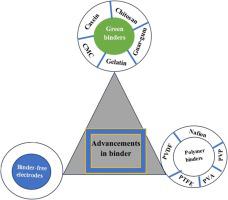当前位置:
X-MOL 学术
›
Eur. Polym. J.
›
论文详情
Our official English website, www.x-mol.net, welcomes your feedback! (Note: you will need to create a separate account there.)
Recent advances in and perspectives on binder materials for supercapacitors–A review
European Polymer Journal ( IF 6 ) Pub Date : 2024-03-16 , DOI: 10.1016/j.eurpolymj.2024.112941 Anit Joseph , Arshitha Mathew , Sneha Perikkathra , Tiju Thomas
European Polymer Journal ( IF 6 ) Pub Date : 2024-03-16 , DOI: 10.1016/j.eurpolymj.2024.112941 Anit Joseph , Arshitha Mathew , Sneha Perikkathra , Tiju Thomas

|
The development of electrode materials, electrolytes, and separators for energy-storage devices has received a great deal of attention. To meet the essential requirements of cutting-edge technologies, including electric vehicles, tremendous effort has been made to develop efficient energy storage device components. Unfortunately, binders have not gotten the same attention despite being crucial to energy-storage devices. Polyvinylidene fluoride (PVDF) has always been the preferred binder in the supercapacitor business. However, PVDF has some limitations, such as low electrical conductivity (10 Sm), insufficient mechanical characteristics, and limited binding strength. In conventional electrodes, the binder is often electrochemically inert, with weak contacts and interfaces between the binder and the active material, which increases “dead mass” and has a direct impact on the performance of the energy storage system. The binder-free electrode is a good contender for addressing the challenges mentioned above. Additionally, to achieve higher sustainability, the notion of green binders has been established using three alternative interpretations, namely (i) processability, (ii) chemical composition, and (iii) natural availability. This review article includes the details of existing and emerging binders in supercapacitors. We included the progress towards the greenness of binder materials and, finally, the advancements of binder-free electrodes.
中文翻译:

超级电容器粘合剂材料的最新进展和展望——综述
用于储能装置的电极材料、电解质和隔膜的开发受到了广泛关注。为了满足包括电动汽车在内的尖端技术的基本要求,人们付出了巨大的努力来开发高效的储能设备组件。不幸的是,尽管粘合剂对能量存储设备至关重要,但它并没有得到同样的关注。聚偏二氟乙烯(PVDF)一直是超级电容器行业的首选粘合剂。然而,PVDF 也有一些局限性,例如导电率低 (10 Sm)、机械特性不足以及结合强度有限。在传统电极中,粘合剂通常具有电化学惰性,粘合剂与活性材料之间的接触和界面较弱,这增加了“死质量”,对储能系统的性能有直接影响。无粘合剂电极是解决上述挑战的有力竞争者。此外,为了实现更高的可持续性,绿色粘合剂的概念已使用三种替代解释建立,即(i)可加工性,(ii)化学成分和(iii)天然可用性。这篇综述文章详细介绍了超级电容器中现有和新兴的粘合剂。我们包括粘合剂材料的绿色化进展,最后,无粘合剂电极的进步。
更新日期:2024-03-16
中文翻译:

超级电容器粘合剂材料的最新进展和展望——综述
用于储能装置的电极材料、电解质和隔膜的开发受到了广泛关注。为了满足包括电动汽车在内的尖端技术的基本要求,人们付出了巨大的努力来开发高效的储能设备组件。不幸的是,尽管粘合剂对能量存储设备至关重要,但它并没有得到同样的关注。聚偏二氟乙烯(PVDF)一直是超级电容器行业的首选粘合剂。然而,PVDF 也有一些局限性,例如导电率低 (10 Sm)、机械特性不足以及结合强度有限。在传统电极中,粘合剂通常具有电化学惰性,粘合剂与活性材料之间的接触和界面较弱,这增加了“死质量”,对储能系统的性能有直接影响。无粘合剂电极是解决上述挑战的有力竞争者。此外,为了实现更高的可持续性,绿色粘合剂的概念已使用三种替代解释建立,即(i)可加工性,(ii)化学成分和(iii)天然可用性。这篇综述文章详细介绍了超级电容器中现有和新兴的粘合剂。我们包括粘合剂材料的绿色化进展,最后,无粘合剂电极的进步。



























 京公网安备 11010802027423号
京公网安备 11010802027423号